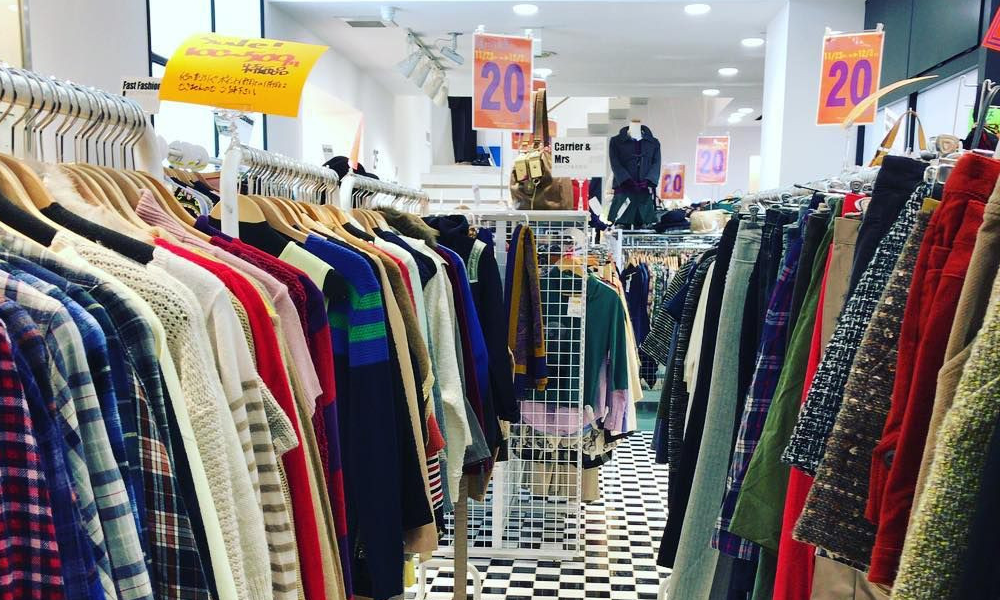Looking For the Best Places to Shop Second-hand Items?
Japanese second-hand shops have a worldwide reputation for offering high quality and low-cost options. Here’s a detailed explanation of why they are so highly regarded.
High-Quality Products
- Strict Quality Control
Japanese second-hand shops rigorously check the condition of their products. Before selling them, we fix or clean items with stains or damages to ensure that consumers can buy high-quality products.
- Abundance of Branded Items
Japan is a good place for luxury brands, and you can also find many of these items in the used market. This allows consumers to buy well-maintained branded items at affordable prices.
Affordable Prices
- Intense Market Competition
With a large number of second-hand shops, the competition is fierce, which benefits consumers. This competition ensures that high-quality products are available at reasonable prices.
- Regular Sales and Discounts
Second hand stores frequently conduct temporary sales and provide price reductions. this makes it possible for consumers to purchase items at even lower prices enhancing cost performance.
Wide Variety of Items
- Diverse Categories
Japan second-hand stores sell a wide range secondhand items, not just clothes. You can discover gadgets, musical instruments, furnishings, hobby materials, and other items that are handy. This variety allows consumers to find everything they need in one place.
- Well-Developed Online Shops
Many second-hand shops also operate online stores, making it easy to purchase items from anywhere in the country. This convenience is particularly beneficial for busy individuals.
Environmental Considerations
- Promotion of Recycling (リサイクル)
The existence of second-hand shops greatly contributes to recycling efforts. By reusing unwanted items, they help reduce environmental impact and promote a sustainable society.
- Part of Eco-Friendly Activities
Purchasing second-hand items is recognized as part of eco-friendly activities. Consumers can obtain high-quality products while also contributing to environmental protection.
The Importance of Sourcing in Making Profits from Second-Hand Clothing
To make profits from selling secondhand clothing stores, sourcing good inventory is crucial. One of the reasons why some people do not make profits is that they do not have a consistent sourcing strategy. Without a reliable source, the cost of goods goes up, making it hard to set a selling price and possibly causing losses.
Additionally, having a limited number of items can also hinder profit. When compared to other stores, having a larger inventory can give you a competitive edge. List about 100 items to gather data on selling and buying prices until you start making a profit.
This will help you understand the balance. Stabilizing the quality and quantity of your sourcing is the shortcut to making profits.
Second-Hand Clothing Sources
Recycling Shops
As a recommended source for beginners, large recycling shops are ideal. They sort items by type to make them easy to find and lower the chance of getting fake or stolen goods. Moreover, It’s a relatively safe sourcing route in buying second hand items.
Recommended Major Recycling Shops




For your initial sourcing, choosing large general recycling shops or major second-hand clothing-specific recycling shops is advisable. Recycling shops with nationwide locations are relatively accessible, making regular sourcing less burdensome. Here are some recommended recycling shops and their features:
Source
Second Street (2nd Street)
Treasure Factory Style
Off House
King Family
Features
Offers a wide range from branded, second-hand, to no-brand items; relatively stable condition/quality. Second Street operates 800 stores nationwide, making it the largest secondhand brand.
Primarily good condition items and well-known brands; prices are market-aligned, utilize sales.
Mostly generic items are available, with branded items being a bit pricier (not recommended for beginners).
Ideal for sourcing women’s and baby clothes; always fresh inventory with daily large arrivals.
Famous recycling stores in Japan that sell brand-name items have strict buying rules. These rules can make it easier for beginners to find items.
Advantages of Sourcing from Recycling Shops
While many use flea markets, recycling shops are better suited for regular sourcing. They offer abundant stock, often categorized by brand, type, and size, making them easier to search. Being able to examine each item directly reduces the risk of overlooking flaws.
This in-person inspection before purchase is a distinct advantage of physical stores. The prices on Physical Stores items are fair, making extremely cheap deals rare. However, regional and store-specific demands vary, so there are still chances to find good deals. Utilizing sales and campaigns can also help source items at lower costs.
Drawbacks of Sourcing from Recycling Shops
Sourcing from recycling shops requires physically visiting the store and carrying items back, which can be cumbersome. Sourcing in bulk without a vehicle is challenging. Even if you find a good source, if it’s far from your base, it becomes less practical. Additionally, finding good items can depend heavily on timing and luck, so sometimes you may return empty-handed.
Online Sourcing
Online sourcing is convenient, allowing you to check items anytime and anywhere. This is ideal for busy individuals or those selling secondhand clothes as a side business. Consider the following tips to source efficiently online.
Recommended Online Sources
When sourcing second-hand clothing online, the following flea market sites and apps are commonly used:




Source
Mercari
Rakuma
Yahoo Auctions
ZOZOUSED
Features
Mainly used by women in their 20s-30s; ideal for sourcing young women’s brands and kids’ clothing.
Primarily female users; relatively low selling prices, suitable for sourcing women’s clothing.
Mainly used by 30s-40s; has both fixed-price and auction systems (starting from 1 yen can yield high profits).
Rich in branded second-hand clothing; initial prices are slightly high, better for advanced users.
If concerned about counterfeit or condition verification on flea market sites, consider ZOZOUSED, which handles branded second-hand clothing. However, note that items quickly move from initial prices to sale prices, so timing your purchase is crucial.
Advantages of Online Sourcing
Sourcing online allows you to complete research and purchase from home, making it efficient. If time constraints prevent you from visiting a store, you can conveniently purchase in bulk from home through online shopping. Additionally, if you buy from amateur sellers or those looking to dispose of items, you can source at low costs.
Drawbacks of Online Sourcing
Sourcing second-hand clothing online can result in receiving items with unseen damages. Amateurs often have poor photo-taking skills or incomplete item descriptions, so thorough checking through questions is necessary.
Uniform Price Second-Hand Shops
Uniform price second-hand shops are popular among students and young people, featuring prices like 500 yen, 700 yen, and 1000 yen. Many individuals run businesses by sourcing from these shops.
Representative Uniform Price Second-Hand Shops
| SOURCE | FEATURES |
|---|---|
| Furugi Shrine | 300 yen uniform price shop in Shinjuku; also has branded items with potential good finds. |
| STICK OUT | 700 yen uniform price shop in Shimokitazawa; mainly sourced from overseas (tops, chinos, jeans). |
| Sputonic | 500 yen uniform price shop in Osaka; mainly women’s and men’s clothing. |
Many uniform price second-hand shops introduce new stock on social media. Check them out if you’re interested in their lineup.
Advantages of Uniform Price Second-Hand Shops
The advantage of uniform price second-hand shops is the low sourcing cost compared to chain stores or overseas-sourced shops. Even if you make a mistake, the loss is minimal, making it suitable for beginners. The uniform sourcing cost also simplifies expense and profit calculations.
Drawbacks of Uniform Price Second-Hand Shops
Uniform price second-hand shops mainly deal in no-brand items, making it difficult to achieve significant profits. To make good profits, you need substantial knowledge and experience.
Wholesale Dealers
Using wholesalers who buy large quantities of second-hand clothing domestically and internationally can also be a sourcing method. Wholesale warehouses is a secret pot of gold, making them worth a visit.
Recommended Wholesalers
Here are three representative wholesalers. Visiting their warehouses during public openings may offer opportunities without minimum purchase requirements.
| SOURCE | FEATURES |
|---|---|
| 3peace | Japanese secondhand store include clothes and accessories imported from overseas (mainly USA). This includes warehouses in Kanto, Nagoya, Sendai, monthly stock of over 60,000 items. |
| TOMIUSED | Large wholesaler in Osaka, sourcing via web and physical (warehouse); reservations required. |
| 03yard | A Tokyo-based wholesaler sells items starting from 1000 yen and offers assorted sales, including lucky bags. |
Searching on social media like Instagram can reveal additional wholesalers.
Advantages of Sourcing from Wholesalers
The main advantage of wholesalers is the ability to source large quantities of freshly acquired stock. Items are often popular brands or trending items, making them easier to sell.
Drawbacks of Sourcing from Wholesalers
Many wholesalers have a minimum purchase requirement, usually around 30,000 to 50,000 yen. You need to find and select sellable items from large, often messy piles, requiring good judgment. Prices are not particularly cheap, so beginners should start with researching recycling shops.
Tips for Making Profits from Second-Hand Clothing Sourcing
Stabilize Monthly Sourcing Volumes
Especially for individual businesses, limited storage space often means difficulty holding inventory. However, stores with low or outdated stock become unappealing. Regularly refreshing inventory keeps your store interesting for customers.
Fix Your Sourcing Route and Use Time Efficiently
Consistently developing new sourcing routes is difficult, so find reliable sources that fit your needs. Once established, you can use the saved time for research and other tasks, improving overall efficiency.
Stay Informed on Trends and Market Movements
Japanese second-hand shops is highly influenced by trends. Securing items that will soon become popular allows you to buy low and sell high. Understanding market trends and identifying rising items is crucial for making profits.
The Trending Japanese Second-Hand Shops
Japanese second-hand shops are a haven for bargain hunters and collectors alike. These shops offer more savings and quality, making them popular among locals and tourists. Exploring Japanese second-hand shops reveals cost efficient shopping from vintage kimonos to modern electronics, all impeccably maintained.
The appeal of Japanese second-hand shops lies in their meticulous curation and the sustainable shopping experience they promote. Whether you’re searching for rare finds or everyday essentials, Japanese second-hand shops provide a memorable shopping adventure.










